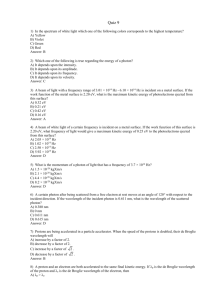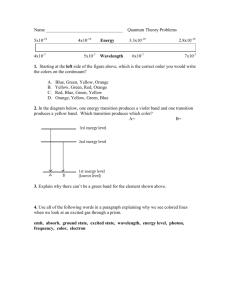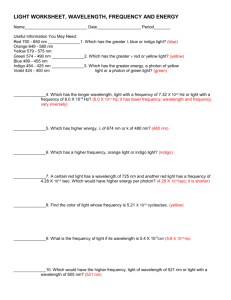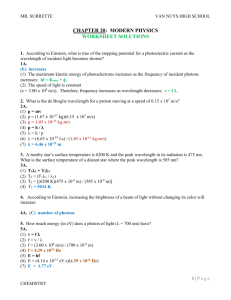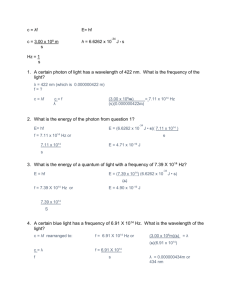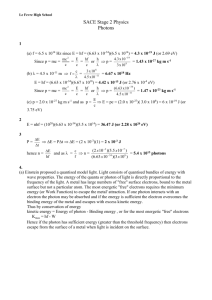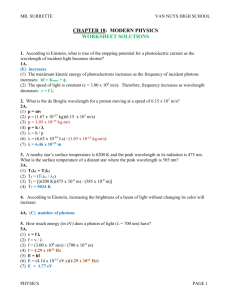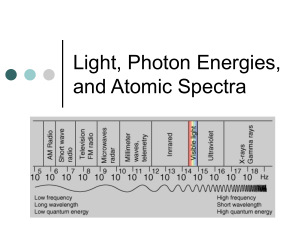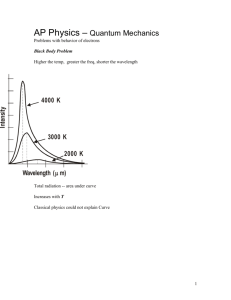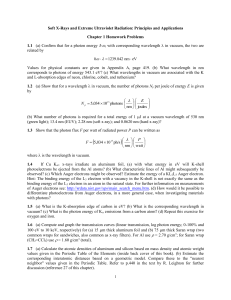Practice Quiz 10
advertisement
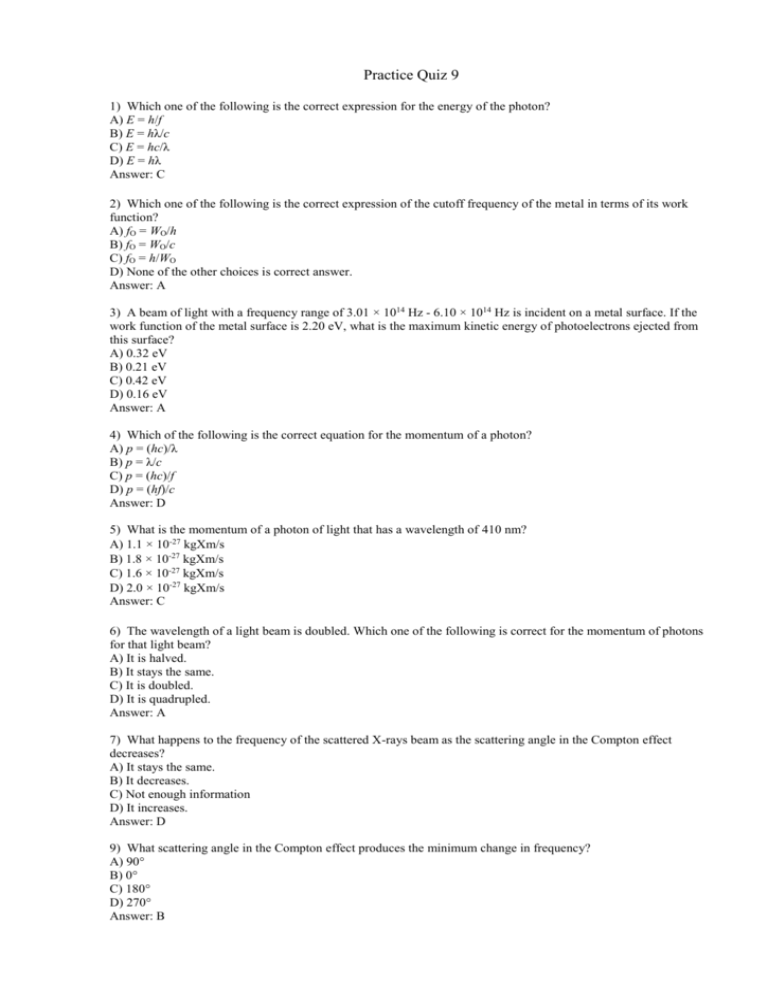
Practice Quiz 9 1) Which one of the following is the correct expression for the energy of the photon? A) E = h/f B) E = hλ/c C) E = hc/λ D) E = hλ Answer: C 2) Which one of the following is the correct expression of the cutoff frequency of the metal in terms of its work function? A) fO = WO/h B) fO = WO/c C) fO = h/WO D) None of the other choices is correct answer. Answer: A 3) A beam of light with a frequency range of 3.01 × 1014 Hz - 6.10 × 1014 Hz is incident on a metal surface. If the work function of the metal surface is 2.20 eV, what is the maximum kinetic energy of photoelectrons ejected from this surface? A) 0.32 eV B) 0.21 eV C) 0.42 eV D) 0.16 eV Answer: A 4) Which of the following is the correct equation for the momentum of a photon? A) p = (hc)/λ B) p = λ/c C) p = (hc)/f D) p = (hf)/c Answer: D 5) What is the momentum of a photon of light that has a wavelength of 410 nm? A) 1.1 × 10-27 kgm/s B) 1.8 × 10-27 kgm/s C) 1.6 × 10-27 kgm/s D) 2.0 × 10-27 kgm/s Answer: C 6) The wavelength of a light beam is doubled. Which one of the following is correct for the momentum of photons for that light beam? A) It is halved. B) It stays the same. C) It is doubled. D) It is quadrupled. Answer: A 7) What happens to the frequency of the scattered X-rays beam as the scattering angle in the Compton effect decreases? A) It stays the same. B) It decreases. C) Not enough information D) It increases. Answer: D 9) What scattering angle in the Compton effect produces the minimum change in frequency? A) 90° B) 0° C) 180° D) 270° Answer: B 9) A certain photon after being scattered from a free electron at rest moves at an angle of 120° with respect to the incident direction. If the wavelength of the incident photon is 0.611 nm, what is the energy of the scattered photon? A) 1.05 × 10-16 J B) 2.10 × 10-16 J C) 5.71 × 10-16 J D) 3.23 × 10-16 J Answer: D 10) You perform Compton scattering experiments with X-rays of a fixed wavelength. In one experiment you scatter the X-rays from free electrons. In the second experiment you scatter the X-rays from protons instead. For X-rays scattered under a given angle, the wavelength change A) will be larger for scattering from protons. B) will be the same for both cases. C) will be larger for scattering from electrons. D) depends on the actual wavelength of the X-rays. Answer: C 11) Protons are being accelerated in a particle accelerator. When the energy of the protons is doubled, their de Broglie wavelength will A) increase by a factor of 2. B) decrease by a factor of 2. C) increase by a factor of 2 . D) decrease by a factor of Answer: D 2. 12) A proton and an electron are both accelerated to the same final speed. If λp is the de Broglie wavelength of the proton and λe is the de Broglie wavelength of the electron, then A) λp > λe. B) λp = λe. C) λp < λe. D) Not enough data to answer this question. Answer: C 13) A beam of light with a frequency range of 3.01 × 1014 Hz - 6.10 × 1014 Hz is incident on a metal surface. If the work function of the metal surface is 2.20 eV, what is the range of frequencies in this beam of light that will be responsible for ejecting electrons from this metal surface? A) 1.12 × 1014 Hz - 3.10 × 1014 Hz B) 3.01 × 1014 Hz - 6.10 × 1014 Hz C) 5.31 × 1014 Hz - 6.10 × 1014 Hz D) None Answer: C 14) Which one of the following equations is correct for the maximum kinetic energy of photoelectrons ejected from a metal? A) Kmax = hc – WO B) Kmax = hf - WO C) Kmax = hλ/c - WO D) None of the other choices is correct answer. Answer: B
